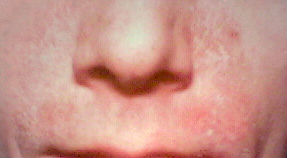Reviewer: S. Randhawa, M.D., Allergist/Immunologist and Assistant Professor at LSU (Shreveport) Department of Allergy and Immunology
A 21-year-old Caucasian male called the allergy clinic to make an appointment for an "allergic skin rash" affecting his face, upper torso and right arm. The rash started above his left eye 2 years ago and spread gradually. It is marked by pruritus even during the night. He has used an aloe vera-based cream and mineral oil daily for the last year without significant improvement. His symptoms are slightly worse in the fall and when he has a hot shower.
The patients wants to have allergy testing to determine what is the cause if his rash.
PMH
Unremarkable.
Social history
Non-smoker; denies IV drug use and high-risk sexual behavior.
Medications
An aloe vera-based cream and mineral oil daily.
Physical examination
VSS, temperature 97.2, heart rate 79, respiratory rate 14, blood pressure 102/60
Thin male in no apparent distress.
Skin: Maculo-papular rash affecting his face and upper back and shoulder blades. Dry scales, oily skin, yellow crusts and scratch marks.
Eyes: Normal.
External auditory canal: Skin scales. Tympanic membranes: Normal.
Nose: Normal.
Lymph nodes: not palpable.
Respiratory system: Clear to auscultation bilaterally.
Cardiovascular system: Clear S1S2.
Gastrointestinal system: +BS, NT, ND.
Extremities: No cyanosis, clubbing, or edema.

Seborrheic dermatitis. Image source: Wikipedia, GNU Free Documentation License.
What is the most likely diagnosis?
This is a male with seborrheic dermatitis with evidence of secondary infections, both fungal and likely impetigo as evidenced by the yellow crusts around the scratch marks.
What laboratory workup would you order?
An HIV test.
He denies having sex with men, IV drug abuse, blood transfusions or any history of positive HIV testing in the past and he declines an HIV test now. We feel that the most likely diagnosis is seborrheic dermatitis with secondary infection.
What treatment would you recommend for this patient?
The patient was reassured that his rash is not of allergic origin and therefore further testing with skin prick tests or specific IgE is not recommended.
He was prescribed:
Augmentin (amoxicillin clavulanate) 875 mg po b.i.d. for 10 days.
Prednisone 40 mg po daily for four days, then stop.
Hydrocortisone cream 1% cream t.i.d., apply topically for no longer than a month.
Nizoral shampoo 2% applied daily to the scalp, apply for 5 minutes, then rinse.
Nizoral 2% cream applied b.i.d. for four weeks.
If there is no response to this treatment at the one-month follow-up appointment, the patient will be referred to dermatology.
Final diagnosis
Seborrheic dermatitis
What did we learn from this case?
Seborrheic dermatitis is a chronic inflammatory disorder which affects areas of the head and trunk where sebaceous glands are most prominent. Scalp seborrhea varies from mild dandruff to dense, diffuse, adherent scale.
Lipophilic yeasts of the Malassezia genus contribute to development of this condition.
Treatment of associated fungal infection is an integral part of the management of moderate to severe seborrheic dermatitis.
References
Treatment of Seborrheic Dermatitis. Johnson et al. Am Fam Physician 2000;61:2703-10,2713-4.
Seborrheic Dermatitis. American Academy of Dermatology.
Seborrheic Dermatitis. Samuel Selden, eMedicine Specialties, Dermatology, 2007.
Dermatitis. Merck Manual.
Seborrheic Dermatitis. Luigi Naldi, M.D., and Alfredo Rebora, M.D. NEJM, Volume 360:387-396 January 22, 2009 Number 4.
Published: 12/23/2008
Updated: 01/21//2009
No comments:
Post a Comment